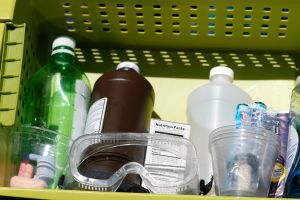Summer is on the way and it’s a great time to have a bin or box of items on hand for when the kids are looking for something to do. Last year I suggested 25 items for investigating physical science. This year let’s gather 25 items that will be sure to excite your child’s inner chemist. (Note: These suggestions are mostly for ages 5+ and always keep safety in mind by reading and following the safety warnings on the labels of any product.)
Chemistry-themed activity box:
1. Measuring cups and spoons
2. Clear plastic cups to serve as beakers – washable and reusable, or clean baby food jars
3. Goggles for eye protection, one set for each child
4. Clean plastic soda or water bottles for mixing
5. A big box of cornstarch, to mix with about equal parts water to make cornstarch goo. Kids of all ages love to revisit this messy activity again and again. Mix outside or cover the table with a large garbage bag for ease of clean up. See also activity 4 of the Agricultural Science post for instructions for making cornstarch plastic.
6. Bubble mix -or the ingredients to make bubbles, see bubble science , rainbow bubbles. Add glow paint or glowing highlighters to make glowing bubbles.
7. Blackboard chalk and/or sidewalk chalk – see what liquids dissolve chalk (water, lemon juice. vinegar, soda, etc.)
8. Hydrogen peroxide – for elephant’s toothpaste
9. Rubbing alcohol – use to build a density column
10. Tonic water and a black light for more glowing chemistry
11. Vegetable oil, food coloring and water to study oil and water separation , make a lava lamp
12. Vinegar– common acid to explore acids and bases
13. Baking soda to make volcanoes and rockets. For an incredibly simple, yet effective volcano: Have your child make a volcano shaped heap in a sandbox or loose soil, if no sandbox is available. Make a hole in the top, about 1 1/2 inches deep, and pour in some baking soda. Then pour in about 1/2 cup vinegar and stand back for the eruption. The cone can be rebuilt again and again. Add red food coloring to the vinegar to simulate lava. (Celebrate Chemistry has more information).
14 . Yeast– see #15 and elephant’s toothpaste (#8)
15. Sugar, balloon and a water bottle. Mix the yeast, sugar and water in the bottom of the water bottle and then cover the opening with the un-inflated balloon. Watch what happens as the yeast begins to grow. Also, add sugar to your bubble mix (#6).
16. Tumeric – can be used as a pH indicator, see acids and bases section of Chemistry Day post.
17. Salt – chemistry of rust, for example
18. Baby oil – density columns and lava lamps
19. Iodine – for older kids, indicates presence of starch. Iodine is available at many pharmacies. See Iodine Chemistry post for experiment ideas
20. Dish detergent– useful for DNA extraction and elephant’s toothpaste (see #8)
21. Mentos candy and soda for geysers – I know it has been overdone and it is definitely a messy outdoor project, but kids do still like it. Soda is also useful for exploring acids and bases.
How to get started from Steve Spangler (there is a pop-up ad):
22. Metal objects such as nails, washers, paper clips, etc. Place in jars with either plain water, water plus salt, or plain vinegar and see what happens. (Chemistry of Rust)
23. pH paper – If you don’t have a favorite science supply store, pH paper can be found in garden supply stores for soil testing or some aquarium suppliers for water testing.
Other items to have on hand in the fridge:
24. Lemon juice can also be used to make invisible ink and with Pennies, nails. Add lemon juice from the kitchen to clean the penny, and copper plate the nail.
25. Red cabbage juice to explore acids and bases, or make a fried green egg
All you need is red cabbage from the grocery store, a blender (adult help), glasses or plastic cups and items to mix with the red cabbage solution, such as lemon juice, soda, vinegar, baking soda, dish detergent and laundry detergent.
Some recipes call for boiling the cabbage (smelly!), but you can just grind up the fresh red cabbage in small batches with enough water to allow the blender to work properly. Pour the batches together in a pitcher, which can be placed in the refrigerator for use later in the day if necessary or even frozen. Pour about 1/3 cup of the red cabbage juice into testing containers such as clear glasses or plastic cups. Then mix in about a Tablespoon of one of the testing compounds. Does the color change? Try another material in the next glass. Does the color change more if you add more test material? What happens if you mix two materials, like vinegar and laundry detergent? Have fun admiring the wild colors you can make.
You can also use frozen mixed berries ground in the blender with a bit of water. The mixed berries smelled better, although they don’t give quite as good a range of colors as the red cabbage.
_________________
We’d love to hear your suggestions for more fun ways to explore chemistry with kids!


Leave a Reply